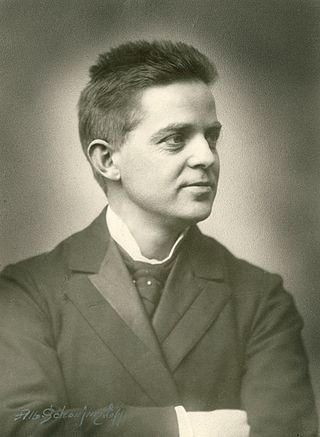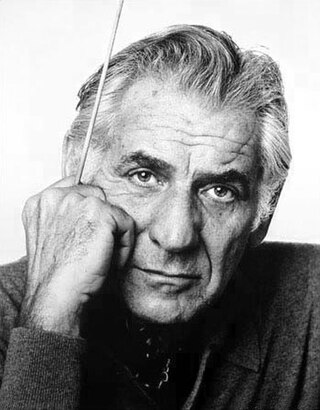Related Research Articles

A pit orchestra is a type of orchestra that accompanies performers in musicals, operas, ballets, and other shows involving music. The term was also used for orchestras accompanying silent movies when more than a piano was used. In performances of operas and ballets, the pit orchestra is typically similar in size to a symphony orchestra, though it may contain smaller string and brass sections, depending upon the piece. Such orchestras may vary in size from approximately 30 musicians to as many as 90–100 musicians. However, because of financial, spatial, and volume concerns, current musical theatre pit orchestras are considerably smaller.
Symphony No. 3 was Aaron Copland's final symphony. It was written between 1944 and 1946, and its first performance took place on October 18, 1946 with the Boston Symphony Orchestra performing under Serge Koussevitzky. If the early Dance Symphony is included in the count, it is actually Copland's fourth symphony.
The Young Person's Guide to the Orchestra, Op. 34, is a 1945 musical composition by Benjamin Britten with a subtitle Variations and Fugue on a Theme of Purcell. It was based on the second movement, "Rondeau", of the Abdelazer suite. It was originally commissioned for the British educational documentary film called Instruments of the Orchestra released on 29 November 1946, directed by Muir Mathieson and featuring the London Symphony Orchestra conducted by Malcolm Sargent; Sargent also conducted the concert première on 15 October 1946 with the Liverpool Philharmonic in the Philharmonic Hall, Liverpool, England.

The Miraculous Mandarin Op. 19, Sz. 73, is a one act pantomime ballet composed by Béla Bartók between 1918 and 1924, and based on the 1916 story by Melchior Lengyel. Premiered on 27 November 1926 conducted by Eugen Szenkar at the Cologne Opera, Germany, it caused a scandal and was subsequently banned on moral grounds. Although more successful at its Prague premiere, it was generally performed during the rest of Bartók's life in the form of a concert suite, which preserves about two-thirds of the original pantomime's music.
The Bachianas Brasileiras are a series of nine suites by the Brazilian composer Heitor Villa-Lobos, written for various combinations of instruments and voices between 1930 and 1945. They represent a fusion of Brazilian folk and popular music on the one hand and the style of Johann Sebastian Bach on the other, as an attempt to freely adapt a number of Baroque harmonic and contrapuntal procedures to Brazilian music. Most of the movements in each suite have two titles: one "Bachian", the other Brazilian.
Sergei Prokofiev wrote the symphonic suite The Year 1941 in 1941.
The Wooden Prince, Op. 13, Sz. 60, is a one-act pantomime ballet composed by Béla Bartók in 1914–1916 to a scenario by Béla Balázs. It was first performed at the Budapest Opera on 12 May 1917 under the conductor Egisto Tango.

French composer Hector Berlioz wrote a number of "overtures", many of which have become popular concert works. They include true overtures, intended to introduce operas, but also independent concert overtures that are in effect the first orchestral tone poems.
The Sacrifice is an opera in three acts composed by James MacMillan with a libretto by the poet Michael Symmons Roberts based on the Branwen story of the Welsh mythology collection, the Mabinogion. The world premiere took place on 22 September 2007 at the Donald Gordon Theatre of the Wales Millennium Centre, Cardiff. The production was staged by Welsh National Opera, directed by Katie Mitchell and conducted by the composer.

The Helios Overture, Op. 17, is a concert overture for orchestra written in 1903 by the Danish composer Carl Nielsen. The piece received its premiere at the Odd Fellows Mansion in Copenhagen on 8 October 1903, with Johan Svendsen conducting the Royal Danish Orchestra.
Chôros is the title of a series of compositions by the Brazilian composer Heitor Villa-Lobos, composed between 1920 and 1929.
Route 66 is a single-movement composition for orchestra by the American composer Michael Daugherty. The piece was commissioned by the Kalamazoo Symphony Orchestra and premiered on April 25, 1998, at the Irving S. Gilmore International Keyboard Festival in East Lansing, Michigan under conductor Yoshimi Takeda.
Time Machine for Three Conductors and Orchestra is a two-movement orchestral composition by the American composer Michael Daugherty. The piece was commissioned by the Pittsburgh Symphony Orchestra and premiered on November 24, 2003, with the Pittsburgh Symphony Orchestra led by the conductors Mariss Jansons, Lucas Richman, and Edward Cumming.
Ghost Ranch is a three-movement orchestral composition by the American composer Michael Daugherty. Inspired by the life and work of artist Georgia O'Keeffe, the title is derived from the name of O'Keeffe's New Mexico summer home, Ghost Ranch. The piece was commissioned by BBC Radio 3, completed in 2005, and premiered February 8, 2006 in Poole, United Kingdom, with the Bournemouth Symphony Orchestra led by conductor Marin Alsop.
The Percussion Concerto No. 2 is a concerto for solo percussion and orchestra by the Scottish composer James MacMillan. The work was jointly commissioned by the Netherlands Radio Philharmonic, the Philharmonia Orchestra, the Orchestre national du Capitole de Toulouse, the Cabrillo Festival of Contemporary Music, the Baltimore Symphony Orchestra, and the São Paulo State Symphony. It was first performed on November 7, 2014 at TivoliVredenburg in Utrecht, the Netherlands, by percussionist Colin Currie and the Netherlands Radio Philharmonic under conductor James Gaffigan. The composition is MacMillan's second percussion concerto after 1992's Veni, Veni, Emmanuel.

Symphony No. 10, Sumé pater patrium: Sinfonia ameríndia com coros (Oratorio) is a composition by the Brazilian composer Heitor Villa-Lobos, written in 1952–53. The broadcast performance of the world-premiere performance under the composer's direction lasts just over 67 minutes.
The Symphony No. 3 is a composition for orchestra by the American composer Ned Rorem. The work was first performed by the New York Philharmonic under the direction of Leonard Bernstein at Carnegie Hall on April 16, 1959.

Divertimento, or Divertimento for Orchestra, is a suite of eight orchestral bagatelles by American composer Leonard Bernstein. Completed in 1980 and written to celebrate the centenary of the Boston Symphony Orchestra, it is well-known for featuring the notes B and C in most of its melodic material.
References
- 1 2 3 4 Bernstein, Leonard (2014). Complete anniversaries: for piano. Boosey & Hawkes. ISBN 978-1-4803-9358-5 . Retrieved 15 April 2020.
- ↑ Shawn, Allen (30 September 2014). Leonard Bernstein: An American Musician. Yale University Press. ISBN 978-0-300-21017-0 . Retrieved 17 January 2022.
- ↑ "Works | Works | Leonard Bernstein". www.leonardbernstein.com. Retrieved 17 January 2022.
- ↑ "BERNSTEIN, L.: Anniversaries / Fancy Free Suite / Candide Overture / Wonderful Town Overture (São Paulo Symphony, Alsop)". www.naxos.com. Retrieved 19 January 2022.
- ↑ "Leonard Bernstein - Anniversaries". www.boosey.com. Retrieved 19 January 2022.
- ↑ "BERNSTEIN, L.: Anniversaries / Fancy Free Suite / Candide Overture / Wonderful Town Overture (São Paulo Symphony, Alsop) - 8.559814". www.naxos.com. Retrieved 19 January 2022.